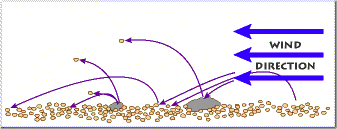Welcome to Kilmurvey Beach! A Blue Flag beach located on the largest of the Aran Islands, Inishmore and a good hike away from Dun Aongus, a 3000 year old ringfort. The posted coordinates is Kilurvey beach, and this is about sand dunes.
Sand Dunes of Kilmurvey
In physical geography, a dune is a hill of loose sand built by aeolian processes (wind) or the flow of water. Dunes occur in different shapes and sizes, formed by interaction with the flow of air or water. Most kinds of dunes are longer on the stoss (upflow) side, where the sand is pushed up the dune, and have a shorter "slip face" in the lee side. The valley or trough between dunes is called a slack. A "dune field" or erg is an area covered by extensive dunes.
Dunes occur in some deserts and along some coasts. Some coastal areas have one or more sets of dunes running parallel to the shoreline directly inland from the beach. In most cases, the dunes are important in protecting the land against potential ravages by storm waves from the sea. Although the most widely distributed dunes are those associated with coastal regions, the largest complexes of dunes are found inland in dry regions and associated with ancient lake or sea beds. Dunes can form under the action of water flow (fluvial processes), and on sand or gravel beds of rivers, estuaries and the sea-bed.
The modern word "dune" came into English from French c. 1790, which in turn came from Middle Dutch dūne.
Formation of Sand Dunes (Coastal)
To form a sand dune, you will need:
- Sand (duh)
- Wind
- A supporting structure

Sand hitting sand is more likely to stick; sand hitting a more coherent surface is more likely to bounce (saltation)
From the image above, sand is picked up by the wind towards the mainland. As the sand continues to pile up, it grows into a dune. However, a sand dune without any support is susceptible to corrosion. Rain, wind or even a strong wave can destroy a sand dune quickly. This is where a supporting structure for the sand dune is needed.
Man-made structures such as fences, breakwaters or ripraps are used to protect coastlines as well as sand dunes. These structures also provide a basis for the sand to accumulate and grow. On a natural scale, beach grass is commonly available, and their roots hold the sand together while their leaves trap sand being carried by the wind.
Logging Tasks
Send the answers to the following questions via my profile and log away. I will get back to you if the answers are unsatisfactory.
- What are the support structures for the sand dunes?
- Can you identify the lee and stoss sides? Why or why not?
- How do you see this sand dune evolve over time?